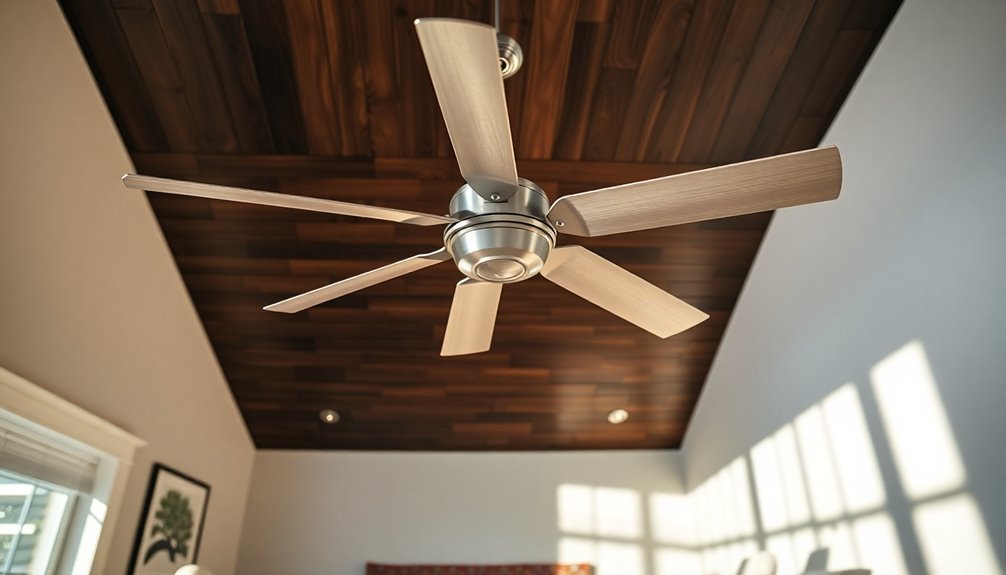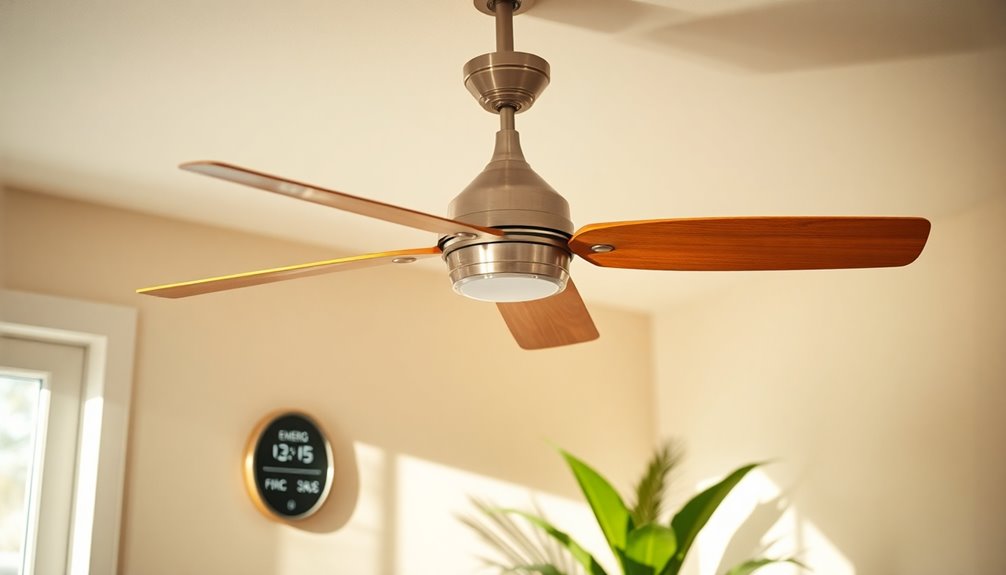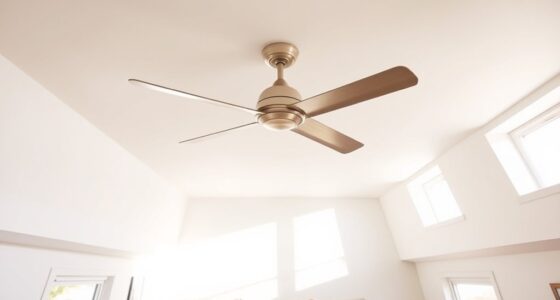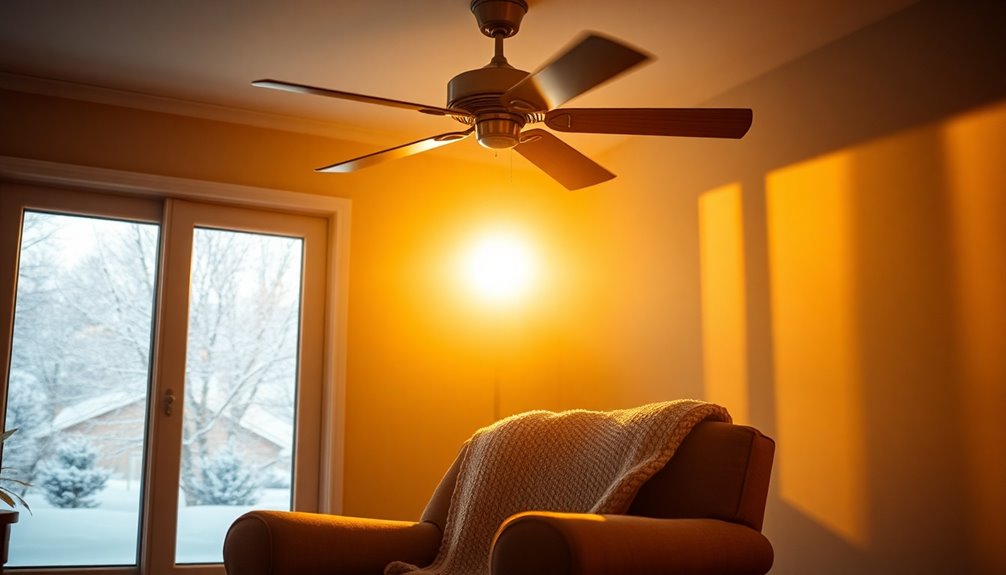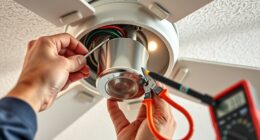Replacing a ceiling fan usually costs between $100 and $500. This price range covers the fan unit, which can be $50 to $300, and labor fees of around $50 to $200. If you need new wiring or have complex setups, the total could climb considerably. DIY installation can save you some cash, but guarantee safety compliance. Don't forget to factor in extra costs, like extension downrods or remote controls, which can add up. For further insights on maximizing savings and choosing the right fan, there's much more to evaluate beyond the basics.
Key Takeaways
- Ceiling fan replacement costs range from $100 to $500, including both the unit and labor fees.
- Labor costs typically range from $50 to $200 per hour, depending on complexity and location.
- Additional expenses may arise from wiring upgrades or removal of existing fans, adding $100 to $850.
- Energy-efficient and smart ceiling fans may have higher upfront costs but offer long-term savings on energy bills.
- DIY installation can save you $50 to $200, but professional installation ensures safety and compliance with regulations.
Average Replacement Costs

When you're considering replacing your ceiling fan, it's important to know that the average cost typically ranges from $100 to $500, depending on the fan's type and how complex the installation is.
The cost of a ceiling fan unit alone can vary from $50 to $300, influenced by size and style. Labor costs for ceiling fan replacement generally range from $50 to $200, with an average installation fee around $150.
If you need new wiring during the replacement, be prepared for a significant increase in total costs, which can soar from $250 to $700. This cost includes both the ceiling fan installation costs and any additional labor required to install the new wiring.
Complex installations, like those involving high ceilings or difficult access points, may further raise your overall expenses.
To keep your budget in check, assess your existing wiring and installation conditions before diving into your ceiling fan replacement.
Factors Affecting Costs
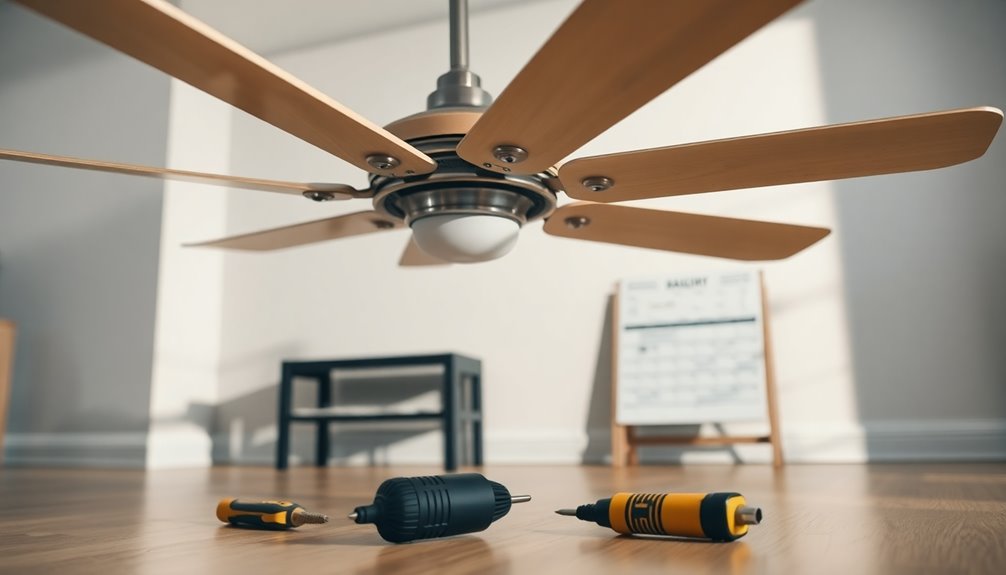
Considering various factors can substantially affect the cost of replacing your ceiling fan. The cost to replace a ceiling fan typically ranges from $100 to $500, but this can vary based on several elements.
First, labor costs can fall between $50 and $200, influenced by installation complexity and local market rates.
Existing wiring plays an essential role; if it's in good condition, you may save on costs. However, if you need new wiring, expect to pay an additional $250 to $700, greatly increasing the overall expense.
Ceiling height also matters—higher ceilings can complicate installation, which can drive up costs due to the need for specialized equipment.
The type of ceiling fan you choose will affect both the purchase price and installation complexity. Standard fans are usually easier to install than smart or directional fans, which might require more intricate wiring and setup. Additionally, choosing energy-efficient models can help save on long-term cooling costs, making them a wise investment.
Types of Ceiling Fans
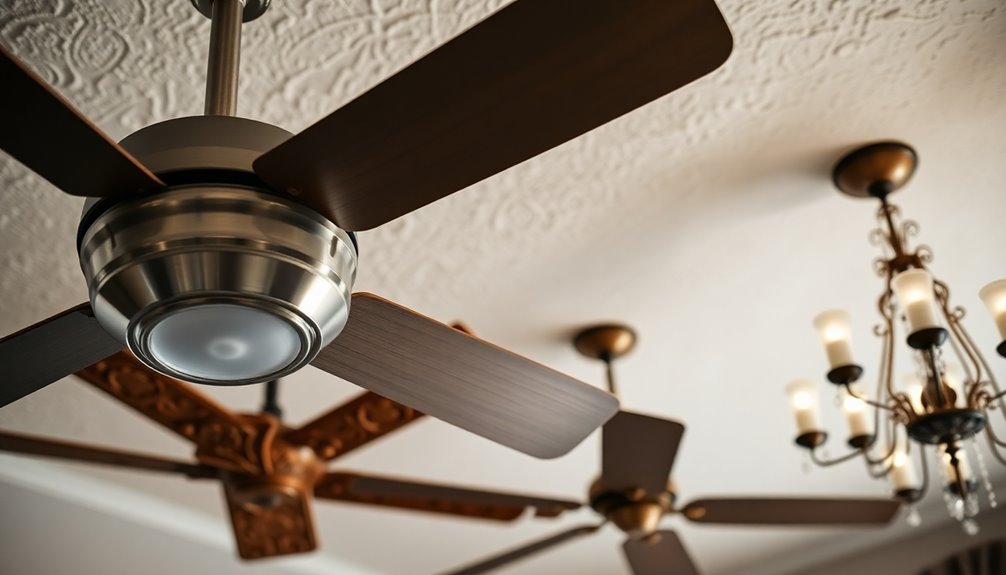
Exploring the various types of ceiling fans can help you find the perfect fit for your space.
Standard ceiling fans are a popular choice, costing between $50 and $300, and often include integrated light fixtures. If you have a lower ceiling, consider low-profile ceiling fans, which also range from $50 to $300 and provide effective air circulation without overwhelming the room.
For specific cooling needs, directional ceiling fans allow you to adjust airflow and generally cost between $150 and $800.
If you need a fan for outdoor areas, outdoor ceiling fans are designed to withstand the elements, with prices ranging from $250 to $3,000, depending on durability and features.
For those looking to embrace modern technology, smart ceiling fans are equipped with Wi-Fi connectivity for remote operation. These tend to be pricier, generally costing between $179.99 and $549.99, but they offer convenience and energy efficiency.
Understanding the types of ceiling fans and their associated costs will help you make an informed decision as you replace your existing fan.
Labor Costs Overview

When you're considering replacing a ceiling fan, understanding labor costs is essential.
Rates can vary widely based on whether you hire a professional or tackle the job yourself.
You'll want to weigh the complexity of the installation against potential savings to make the best choice for your situation.
Labor Rate Variability
Labor costs for replacing a ceiling fan can vary considerably based on several factors, including your location and the complexity of the installation.
Typically, you'll see labor rates ranging from $50 to $200 per hour. In urban areas, these costs often trend higher, ranging from $50 to $130 per hour for licensed electricians, while handyman services usually charge between $50 and $80 per hour.
If you're opting for a basic installation, it'll likely take about 1-2 hours, but more complex setups could extend to 3-4 hours. This added time directly impacts your total labor costs.
If you plan to replace multiple ceiling fans at once, consider that this can lead to reduced overall labor costs due to savings on travel fees and setup time.
Ultimately, understanding these variables can help you budget more accurately for your ceiling fan replacement.
Whether you choose a handyman or a licensed electrician, knowing the complexity of the installation and your specific location will guide your decision on the best service to hire.
DIY vs. Professional Costs
Deciding between a DIY approach and hiring a professional for your ceiling fan replacement can considerably impact your budget. If you choose to tackle the installation yourself, you could save between $50 to $200 in labor costs. Your savings will depend on your skill level and the complexity of the installation.
However, if you're unsure about your electrical skills, it might be wise to hire an electrician.
Professional labor costs typically range from $50 to $200 per hour, with most ceiling fan installations taking about 1-2 hours. Electricians usually charge between $50 and $130 per hour, but if your installation is complex, expect higher rates.
Alternatively, a handyperson may offer lower rates, around $50 to $80 per hour, though their expertise may not cover intricate electrical work.
Keep in mind that hiring a professional can lead to additional costs for permits or modifications to existing wiring, potentially adding $100 to $300 to your total project cost.
Weighing these factors will help you decide whether to go DIY or opt for professional installation based on your budget and comfort level with electrical work.
DIY vs. Professional Installation

When deciding between DIY and professional installation for your ceiling fan, you need to weigh the cost differences and installation complexity.
While tackling it yourself might save you some cash, it's essential to take into account your electrical skills and the safety regulations involved.
Hiring a professional could guarantee compliance and peace of mind, especially for more complicated setups.
Cost Comparison Overview
Replacing a ceiling fan can vary greatly in cost depending on whether you tackle the project yourself or hire a professional. If you choose DIY installation, you can expect total expenses to fall between $100 and $275. This approach saves on labor costs, but keep in mind that you'll need tools and some electrical knowledge to guarantee safety and compliance.
On the other hand, professional installation typically ranges from $60 to $250 per hour, with average installation times of 1 to 2 hours. This means the ceiling fan installation cost can quickly add up, especially if complex wiring is involved. Hiring a licensed electrician can be beneficial for these scenarios, as they ensure compliance with safety regulations and may offer warranties on their work.
While DIY may seem appealing due to lower upfront costs, mistakes can lead to additional costs for repairs or replacements in the future.
Ultimately, weigh the potential savings against the peace of mind that comes with professional installation when deciding how to proceed with your ceiling fan project.
Installation Complexity Factors
Installation complexity plays an essential role in determining whether you should take on a ceiling fan project yourself or hire a professional. If you're dealing with existing wiring that's in good condition and your ceiling height is manageable, you might save on labor costs by opting for a DIY installation.
DIY projects can lower your expenses to between $100 and $275. However, it's vital you have a solid understanding of electrical work to avoid potential hazards.
On the other hand, if your fan requires new wiring or if the installation involves complex configurations, professional installation is the safer route. Licensed electricians typically charge between $50 to $130 per hour, and their expertise guarantees compliance with safety regulations.
While hiring a pro may seem pricey upfront, it can save you from costly mistakes and damage, especially for fans with remote controls or integrated light fixtures.
Consider the installation complexity before diving in. Basic installations generally take 1-2 hours, while more intricate setups can extend to 3-4 hours.
Weighing these factors will help you make the best decision for your ceiling fan project.
Safety and Compliance Considerations
Ensuring safety and compliance is essential, especially if you're considering a DIY ceiling fan project. While it might seem like a cost-effective solution, managing safety regulations and local building codes can be tricky without the right knowledge.
Incorrect installations can lead to serious electrical hazards, ceiling damage, or safety violations that could put you and your home at risk.
Hiring licensed electricians is often the best choice for new wiring or complex installations. They know the importance of using a ceiling fan-rated junction box, ensuring it meets the necessary weight and support requirements.
This professional installation not only guarantees compliance with safety regulations but also minimizes risks associated with improper setups.
Additionally, opting for professional help can provide you with peace of mind. Many electricians offer warranties on their work, so if issues arise down the road, you won't have to worry about extra costs.
While DIY may save you some money upfront, the potential for errors and safety violations often outweighs those savings. When it comes to something as vital as electrical work, investing in professional installation is a smart choice. Moreover, considering the cost of home security systems may help you make informed decisions about overall home safety investments.
Budgeting for Replacement

When it comes to budgeting for a ceiling fan replacement, you'll want to factor in several key expenses to avoid surprises. The average costs for replacing a ceiling fan range from $100 to $500, which includes both labor and materials.
Labor can be a significant part of your budget, typically costing between $50 and $200 per hour. If your ceiling fan installation job requires new wiring, prepare for costs to soar, potentially reaching between $250 to $700.
Don't forget to include the expense of removing the existing fan, which can add an additional $50 to $150. To keep your budget balanced, consider selecting a mid-range ceiling fan priced between $150 and $350. This range guarantees you get good quality without breaking the bank.
It's also wise to set aside an extra 10-20% of your budget for unexpected costs. These could arise from necessary electrical upgrades or permits that weren't initially considered. Additionally, investing in a ceiling fan with energy efficiency ratings can help reduce your long-term utility bills.
Additional Accessories and Costs

When you're choosing a ceiling fan, don't forget about the extra accessories that might be necessary for proper installation.
Extension downrods can cost anywhere from $10 to $75, while remote control options can range from $30 to $100, depending on the features you want.
These additional costs can greatly affect your total budget, so it's smart to factor them in early.
Extension Downrods Pricing
For those looking to enhance their ceiling fan's performance, extension downrods are an important consideration. These downrods come in various lengths, typically ranging from 12 inches to 72 inches, and are vital for achieving ideal airflow, especially in rooms with high ceilings. The right downrod guarantees your ceiling fan operates efficiently, helping to circulate air effectively.
Here's a quick overview of extension downrod pricing:
| Length (inches) | Estimated Cost |
|---|---|
| 12 | $10 – $20 |
| 24 | $15 – $30 |
| 36 | $20 – $40 |
| 48 | $30 – $60 |
| 72 | $50 – $75 |
Pricing varies based on length and material, so it's a good idea to choose compatible downrods offered by your ceiling fan's manufacturer to match the finish. In some cases, your installation project may require multiple downrods to achieve the desired fan height and clearance from the ceiling. Overall, investing in the right extension downrods will greatly enhance your ceiling fan's performance and airflow efficiency.
Remote Control Options
Enhancing your ceiling fan experience doesn't stop with choosing the right downrod; remote control options can greatly increase convenience and functionality.
Many ceiling fans now come with integrated remote controls, making it easy to adjust settings from anywhere in the room. If your fan doesn't include one, a standalone remote receiver typically costs around $30.
For those looking for a modern upgrade, smart fan switch kits allow you to control your fan via an app, ranging from $30 to $100. Wireless remote controls are another excellent option, especially for hard-to-reach fans, often available as ceiling fan accessories from manufacturers.
If you prefer a simpler mechanism, pull chains can serve as an alternative or a complement to remote controls, with decorative options costing between $5 and $15.
Keep in mind that these remote control options can add $30 to $100 to your overall installation cost, depending on the type you choose.
Whether you want the simplicity of pull chains or the tech-savvy features of a smart switch, enhancing your ceiling fan setup is well within reach.
Energy Efficiency Considerations
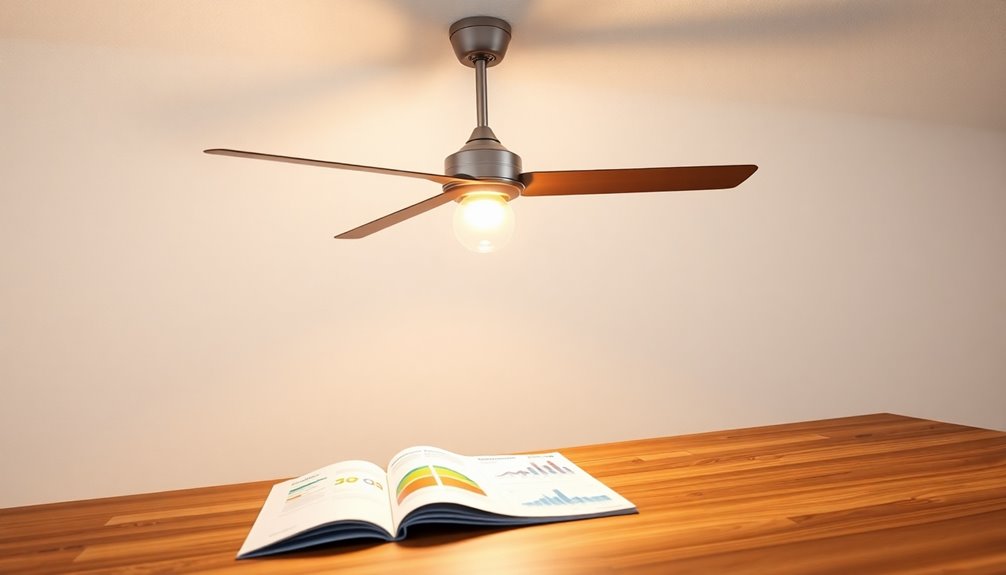
Choosing an energy-efficient ceiling fan not only helps you save money on electricity bills but also contributes to a more sustainable home. Energy-efficient ceiling fans, often rated by ENERGY STAR, can reduce energy costs by up to 60% compared to traditional models. This leads to significant long-term savings, making them a smart investment.
One key factor to take into account is the type of motor. Fans equipped with DC motors use up to 70% less energy than conventional AC motors, enhancing overall energy efficiency.
Additionally, the size and airflow efficiency of your chosen fan are important; larger fans with higher airflow ratings cool larger spaces more effectively, which can minimize reliance on air conditioning.
If you're looking for even more control over your energy consumption, think about ceiling fans with built-in timers or smart technology. These features can help you save an additional 30% on energy costs by preventing unnecessary operation.
With an average lifespan of around 10 years, the initial investment in an energy-efficient ceiling fan can often be recouped within just a few years through the savings on your utility bills. Furthermore, many high-end ceiling fans also come with integrated lighting options that can enhance both functionality and aesthetics in your living space.
Hiring a Qualified Installer

When it comes to installing a ceiling fan, hiring a qualified installer is vital for guaranteeing a safe and efficient setup. A professional electrician can handle the complexities of installation labor, making sure everything meets local building codes. The cost of labor typically ranges from $50 to $200 per hour, depending on your location and the installation's complexity.
To start, it's wise to get free estimates from multiple ceiling fan installers. Utilizing platforms like HomeGuide can connect you with over 20 installers in your area. They can provide thorough estimates that factor in labor and any necessary materials, such as junction boxes or wiring upgrades, which can range from $100 to $300.
Before you commit, verify the credentials and insurance of any installer. This step is important to confirm compliance with safety regulations. You can also seek recommendations from friends or family, or check online reviews, to identify reliable installers with a proven track record of quality work.
Cost-Saving Tips

Looking to save some cash on your ceiling fan replacement? You can use several cost-saving tips to keep your budget intact while enhancing your home improvement project.
Consider installing multiple ceiling fans at once; this can lower your overall costs by sharing travel fees and securing lower hourly rates from installers. Another great idea is to buy ceiling fans during off-peak seasons, which can save you 10-20% off retail prices.
If you have existing wiring, opt for fans that utilize it. This choice can save you between $100 to $500 on installation costs. Choosing energy-efficient ceiling fans not only helps your wallet short-term but also cuts down on utility bills long-term, offsetting initial expenses. Additionally, look for hotels that offer water park access as part of their amenities, which can provide fun for the entire family during your home improvement project.
Lastly, think about hiring a handyman for simpler installations instead of a licensed electrician. If the existing wiring is usable, you could save $50 to $200 on labor.
| Tip | Savings Potential |
|---|---|
| Install multiple fans | Lower labor costs |
| Purchase off-peak | Save 10-20% |
| Use existing wiring | Save $100 to $500 |
| Hire a handyman | Save $50 to $200 |
Implement these strategies, and you'll definitely save money!
Frequently Asked Questions
How Much Does It Cost to Remove and Replace a Ceiling Fan?
When you're considering the cost to remove and replace a ceiling fan, you'll find it typically ranges from $100 to $500.
This depends on installation complexity and the fan type you choose. Labor costs usually fall between $50 to $200, with installations taking 1 to 4 hours.
If you're handy with basic electrical work, opting for a DIY approach could save you money, bringing your total down to about $100 to $275.
How Much Does Home Depot Charge to Install a Fan?
When you're looking to install a ceiling fan at Home Depot, you can expect charges between $100 to $300, depending on how complex the job is and your current wiring.
If you need new wiring, costs might rise to $250 to $700. Home Depot offers free estimates, so you'll know what to anticipate before committing.
Don't forget to contemplate additional costs for components like remote controls, which can add $30 to $100.
How Much Does It Cost to Install a Ceiling Fan in Labor?
When you're considering the cost to install a ceiling fan in labor, it typically ranges from $100 to $500.
If you hire an electrician, expect to pay around $150 for the first hour, with additional hours costing between $50 and $130.
A handyman might be a more budget-friendly option, charging between $50 and $80 per hour, especially if the existing wiring is usable.
Keep your project's complexity in mind for accurate estimates!
Is It Hard to Replace an Existing Ceiling Fan?
Did you know that nearly 20% of homeowners tackle DIY ceiling fan replacements?
It isn't hard to replace an existing ceiling fan if you've got basic electrical knowledge and some tools. With compatible wiring and a sturdy ceiling box, you can usually complete the job in 1-2 hours.
However, if you face height issues or need new wiring, it might get tricky, and you might want to call in an electrician.
Conclusion
Replacing your ceiling fan can feel like turning the page to a new chapter in your home's story. By investing wisely, you're not just swapping out an old fixture; you're inviting fresh breezes and brighter days into your space. Remember to weigh your options, consider the costs, and decide whether to go it alone or enlist a pro. In the end, it's about creating a comfortable sanctuary where you can gather, dream, and thrive.

